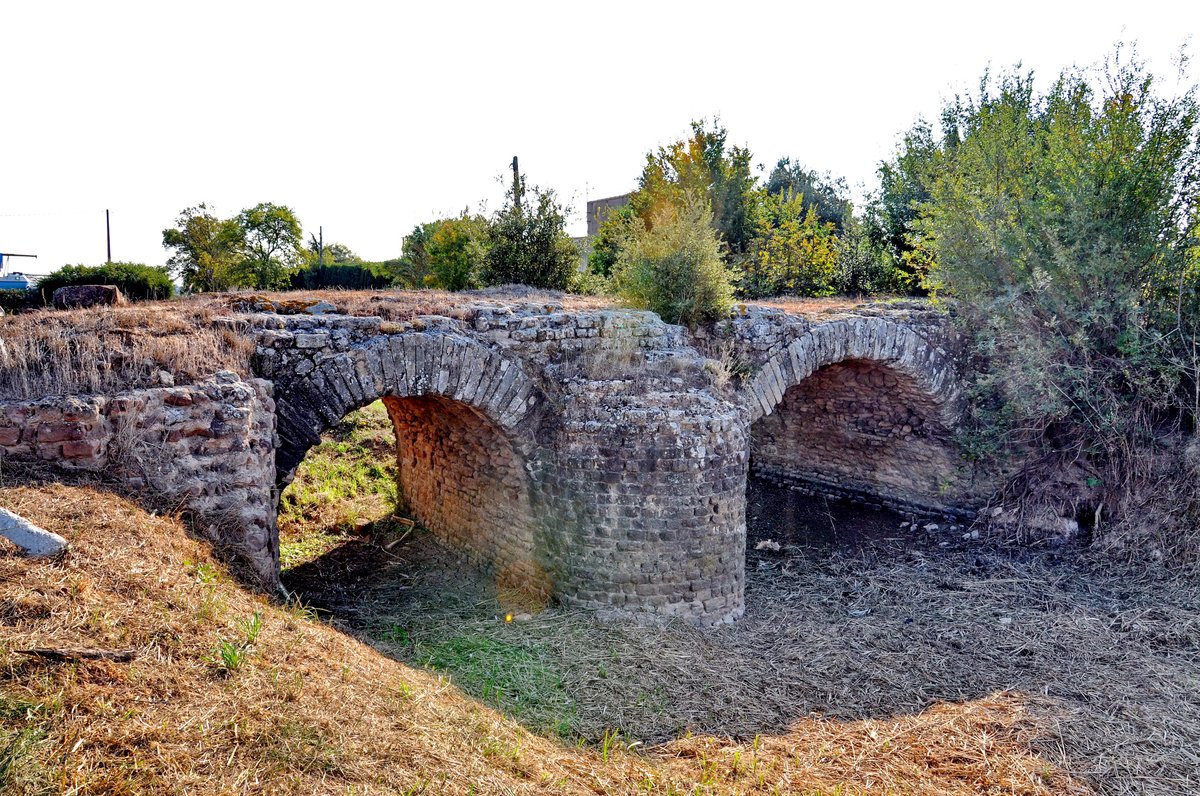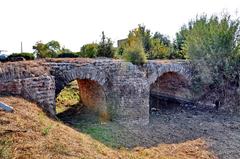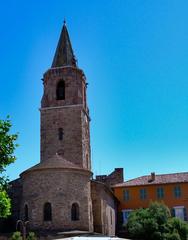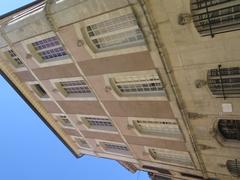
Pont des Esclapes: Visiting Hours, Tickets, and Travel Guide in Fréjus, France
Date: 14/06/2025
Introduction to Pont des Esclapes
The Pont des Esclapes in Fréjus, nestled within the Provence-Alpes-Côte d’Azur region of southeastern France, is a striking testament to Roman engineering and regional history. Dating to the 1st century CE, this ancient bridge once played a crucial role in connecting the Roman colony of Forum Julii (modern Fréjus) with its hinterlands, supporting trade, military movement, and water management across the Argens valley. Its enduring semicircular arches, constructed from local stone without mortar, brilliantly showcase the durability and sophistication of Roman infrastructure (Ville de Fréjus; Structurae Database).
Today, the Pont des Esclapes offers visitors an evocative glimpse into the ancient world, blending archaeological importance with a serene setting near the Reyran River. The bridge features as part of Fréjus’s extensive Roman heritage, alongside sites such as the amphitheater, aqueducts, and city walls. Despite its partial preservation and its location on private property, the site is accessible year-round and free to the public, making it a must-see for history enthusiasts, architecture lovers, and travelers in southern France (Monuments Historiques; Experience Côte d’Azur).
This guide provides an in-depth look at the Pont des Esclapes’ history, architectural features, cultural value, and practical information for planning your visit, including opening hours, accessibility, travel advice, and nearby attractions (France This Way; Over Your Place).
Table of Contents
- Introduction
- Roman Origins and Construction
- Architectural Features
- Historical Role in Roman Fréjus
- Medieval and Modern History
- Archaeological Investigations and Preservation
- Cultural and Symbolic Significance
- Visiting the Pont des Esclapes: Practical Information
- Frequently Asked Questions (FAQ)
- Conservation and Visitor Responsibility
- Conclusion
- Sources
Roman Origins and Construction
Constructed in the 1st century CE, the Pont des Esclapes was integral to the infrastructure of Forum Julii, facilitating movement across the Reyran River and supporting the economic and military activities of the Roman colony (Ville de Fréjus). The bridge was built using locally quarried stone and the classic Roman arch technique, originally comprising several arches, of which only a portion remains today (Structurae Database).
Architectural Features
The bridge exemplifies Roman engineering, with precisely cut limestone blocks assembled without mortar. The main surviving arch spans approximately 5.5 meters, and the original bridge is believed to have been about 30 meters in length (Patrimoine de France). Characteristic elements include semicircular arches, voussoirs, and a prominent keystone—hallmarks of robust Roman bridge construction.
Historical Role in Roman Fréjus
Fréjus was a key urban center in Roman Gaul, with the Pont des Esclapes serving to connect the city to its agricultural hinterlands and the Via Aurelia, a major coastal Roman road (France This Way). The bridge’s name, “Esclapes,” likely refers to the stone slabs used in its construction.
Medieval and Modern History
Following the fall of the Roman Empire, the bridge continued to be used and maintained through the medieval era (Monuments Historiques). In modern times, its functional importance faded due to new infrastructure, but it remains a protected historic monument and a symbol of Fréjus’s layered history.
Archaeological Investigations and Preservation
Interest in the Pont des Esclapes intensified during the 19th and 20th centuries, leading to archaeological surveys and research that have shed light on its construction and historical context (Archéologie en Provence). Listed as a Monument Historique since 1927, ongoing conservation efforts focus on structural stability and visitor accessibility.
Cultural and Symbolic Significance
The bridge is emblematic of the lasting legacy of Roman civilization in Provence and is featured in local cultural itineraries and educational programs (Provence Guide). It serves as a focal point for understanding the region’s ancient roots and continuous settlement.
Visiting the Pont des Esclapes: Practical Information
Visiting Hours and Admission
- Open-air site: Accessible year-round
- No entry fee: Free to visit at any time
- Recommendation: Visit during daylight hours for safety and best visibility
Accessibility
- By Foot: Reachable via well-maintained paths from central Fréjus
- Mobility limitations: Terrain may be uneven; caution is advised for visitors with reduced mobility
Directions
- By Car: Park near Fréjus city center, then follow local roads or paths to the site
- By Public Transport: Local buses serve the area; consult the Fréjus Tourist Office for schedules
Guided Tours and Special Events
Guided tours are occasionally available through local heritage organizations, especially during cultural festivals or heritage days. Check with the Fréjus Tourist Office for current opportunities.
Photography Tips
Early morning and late afternoon provide the best natural lighting for photography. The bridge’s rural setting, framed by Mediterranean vegetation and the Reyran River, offers a picturesque backdrop.
Nearby Attractions
- Fréjus Roman Amphitheater: A well-preserved 1st-century arena
- Cathedral and Episcopal City: One of France’s oldest Christian complexes
- Archaeological Museum: Home to Roman artifacts and interpretive exhibits
- Esterel Mountains: Ideal for hiking and panoramic views
- Coastal beaches and local markets: Experience Provençal culture and cuisine
Frequently Asked Questions (FAQ)
What are the Pont des Esclapes visiting hours?
The site is accessible outdoors 24/7, though daylight hours are recommended.
Is there an entrance fee?
No, visiting the Pont des Esclapes is free of charge.
How do I reach the bridge?
It is located north of Fréjus city center, near the ZA les Esclapes industrial area. Use GPS or digital maps for easy navigation.
Are guided tours available?
Occasional guided tours are organized by local heritage groups; check with the tourist office for schedules.
Is the site accessible for people with disabilities?
Accessibility is limited due to uneven terrain, but the bridge can be viewed from nearby paths.
Conservation and Visitor Responsibility
The Pont des Esclapes is a protected Monument Historique, and visitors are urged to respect its integrity. Please:
- Stay on marked paths
- Refrain from climbing or disturbing the structure
- Avoid littering
- Report any damage to local authorities
Supporting local museums and heritage initiatives helps ensure ongoing preservation (Structurae).
Conclusion
The Pont des Esclapes stands as an enduring symbol of Roman ingenuity and the rich, multi-layered history of Fréjus. Its robust arches and serene setting invite visitors to experience the legacy of the ancient world amidst Provence’s natural beauty. Plan your visit alongside other Roman and cultural sites in Fréjus for a comprehensive historical journey. For current updates, guided tour schedules, and cultural events, download the Audiala app and stay connected through local heritage organizations.
Embrace the opportunity to explore this remarkable bridge—where every stone tells a story of resilience, innovation, and the enduring spirit of Roman civilization in southern France.
Sources and Further Information
- Ville de Fréjus
- Structurae Database
- Patrimoine de France
- Monuments Historiques
- France This Way
- Experience Côte d’Azur
- Over Your Place
- Provence Guide
- Fréjus Tourist Office
- cv.hal.science
Images and interactive maps of the Pont des Esclapes can be found on the official Fréjus tourism website and heritage portals. For accessibility, alt text such as “Pont des Esclapes Roman bridge in Fréjus” is recommended.



